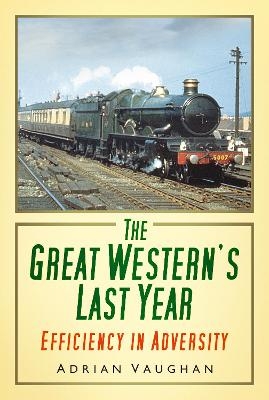
The Great Western's Last Year
Efficiency in Adversity
Seiten
2013
The History Press Ltd (Verlag)
978-0-7524-6532-6 (ISBN)
The History Press Ltd (Verlag)
978-0-7524-6532-6 (ISBN)
DESPITE being one of the best-known and admired rail companies in the country, by 1947 the GWR was at the lowest ebb of its entire history.
Despite being one of the best-known and admired rail companies in the country, by 1947 the GWR was at the lowest ebb of its entire history. Worn out by war, there had been no maintenance for six years and the government couldn’t supply the steel it needed for repair. The latter half of the 1940s presented a multitude of challenges to overcome, some due to the recent war and others individual to the GWR: the staff coped with rationing, a desperately cold winter and a blazing hot summer, and dealt with floods, collisions, broken rails and failing locomotives. The incredible strength of character and can-do attitude of GWR workers kept the railway running through it all. This history, taken from GWR papers and illustrated from them throughout, reveals the details of every day, as well as the problems and difficulties the staff faced. Above all, it shows how well they overcame their problems with only muscle power and a steam crane to help – and, of course, no health and safety regulations and arguments to slow them down. Adrian Vaughan’s unique history of this famous rail company shows just how special the GWR was right through to the end of its very last year.
Despite being one of the best-known and admired rail companies in the country, by 1947 the GWR was at the lowest ebb of its entire history. Worn out by war, there had been no maintenance for six years and the government couldn’t supply the steel it needed for repair. The latter half of the 1940s presented a multitude of challenges to overcome, some due to the recent war and others individual to the GWR: the staff coped with rationing, a desperately cold winter and a blazing hot summer, and dealt with floods, collisions, broken rails and failing locomotives. The incredible strength of character and can-do attitude of GWR workers kept the railway running through it all. This history, taken from GWR papers and illustrated from them throughout, reveals the details of every day, as well as the problems and difficulties the staff faced. Above all, it shows how well they overcame their problems with only muscle power and a steam crane to help – and, of course, no health and safety regulations and arguments to slow them down. Adrian Vaughan’s unique history of this famous rail company shows just how special the GWR was right through to the end of its very last year.
ADRIAN VAUGHAN began to learn about the railway in 1946 at only 6 years old, riding the engines and asking questions. He started learning signal-box work in 1950 and was coached in engine driving, hands-on, in 1953–54. After leaving the army, he joined British Railways (WR) as a lad porter (one was not deemed adult until the age of 21). A signalman from 1961 to 1975, he began writing about the railway in 1970 and has now published over thirty books on the subject. He lives in Norfolk.
| Erscheint lt. Verlag | 1.9.2013 |
|---|---|
| Verlagsort | Stroud |
| Sprache | englisch |
| Maße | 165 x 235 mm |
| Gewicht | 320 g |
| Themenwelt | Natur / Technik ► Fahrzeuge / Flugzeuge / Schiffe ► Schienenfahrzeuge |
| Geschichte ► Teilgebiete der Geschichte ► Wirtschaftsgeschichte | |
| Technik | |
| ISBN-10 | 0-7524-6532-5 / 0752465325 |
| ISBN-13 | 978-0-7524-6532-6 / 9780752465326 |
| Zustand | Neuware |
| Haben Sie eine Frage zum Produkt? |
Mehr entdecken
aus dem Bereich
aus dem Bereich
die Rhätische Bahn schreibt Geschichte
Buch | Hardcover (2023)
Edition Somedia (Verlag)
CHF 63,90
St. Moritz – Zermatt : die Traumreise im langsamsten Schnellzug der …
Buch | Hardcover (2023)
Verlag Berg & Tal
CHF 25,90
Betriebsmaschinendienst, Einsatz bei den Bahnbetriebswerken und …
Buch | Hardcover (2024)
EK-Verlag
CHF 68,90


